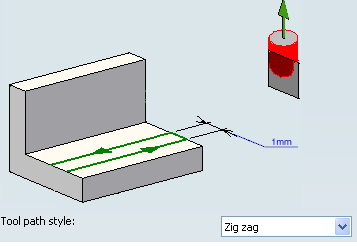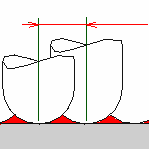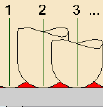Groove Milling | |||||
|
| ||||
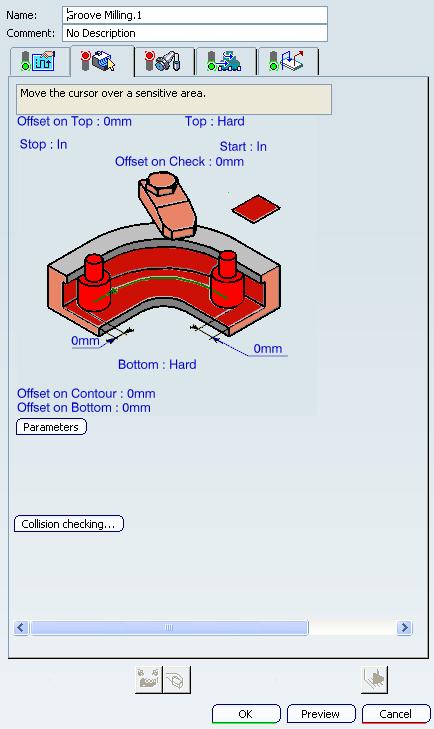
![]()
Machining Parameters
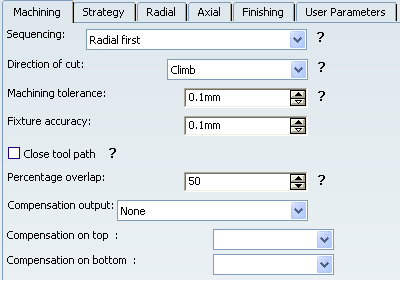
- Sequencing
The options in the Sequencing dropdown combo box are as follows:
- Axial first: axial machining is done first then radial
- Radial first: radial machining is done first then axial.
- Direction of cut
- Specifies how machining is to be done.
The options in the Direction of cut dropdown combo box are as follows:
- Climb milling: the front of the advancing tool (in
the machining direction) cuts into the material first.
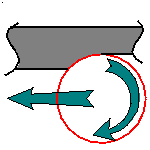
- Conventional: the rear of the advancing tool (in
the machining direction) cuts into the material first.
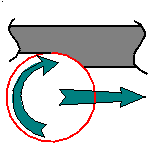
- Climb milling: the front of the advancing tool (in
the machining direction) cuts into the material first.
- Machining tolerance
- Specifies the maximum allowed distance between the theoretical and computed tool path.
- Fixture accuracy
- Specifies a tolerance applied to the fixture thickness. If the distance between the tool and fixture is less than fixture thickness minus fixture accuracy, the position is eliminated from the trajectory. If the distance is greater, the position is not eliminated.
- Close tool path
- Select this check box to specify whether
or not the program must close the tool path:
- Close tool path is selected:
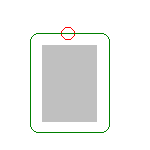
- Close tool path is not selected:
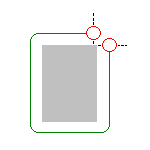
- Close tool path is selected:
- Percentage overlap
- Specifies the
amount that the tool must go beyond the end point of a closed tool path
according to a percentage of the tool diameter.
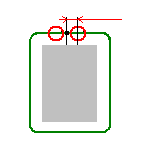
- Compensation output
- The options in the
Compensation output dropdown combo box manage the generation of Cutter compensation (CUTCOM) instructions, and are as follows:
- 2D Radial profile: both the tool tip and
cutter profile can be visualized during tool path replay. Cutter compensation
instructions are automatically generated in the NC data output. An approach
macro must be defined to allow the compensation to be applied.
Note: A negative Offset on contour (parameter in Geometry tab) is possible for 2D radial profile output.
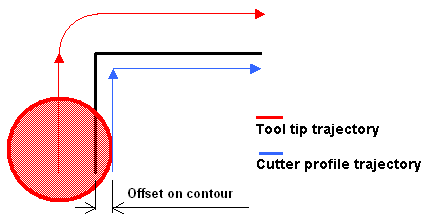
- 2D Radial tip: the tool tip can be visualized during tool path replay. Cutter compensation instructions are automatically generated in the NC data output. An approach macro must be defined to allow the compensation to be applied.
- None: cutter compensation instructions are not generated in the NC data output. In this case, refer to Procedure for Generating CUTCOM Syntaxes.
Note: The PP words in macros you define are added to the cutter compensation instructions generated in the NC data output. Therefore be careful when specifying CUTCOM instructions in macros.
- 2D Radial profile: both the tool tip and
cutter profile can be visualized during tool path replay. Cutter compensation
instructions are automatically generated in the NC data output. An approach
macro must be defined to allow the compensation to be applied.
- Compensation on top and Compensation on bottom
- Specifies the tool corrector identifiers used in the operation. This point is switched automatically during a Return between levels macro whenever the next level to machine requires a different compensation point. The corrector type (P1, P2, P3, for example), corrector identifier, and corrector number are defined on the tool. When the NC data source is generated, the corrector number can be generated using specific parameters.
![]()
Strategy Parameters

- Machining direction
- The options in the
Machining direction dropdown combo box define how
the distance between two consecutive levels is computed, and
are as follows:
- Top/Bottom
- Bottom/Top
- Axial strategy
- The options in the
Axial strategy dropdown combo box defines how the
tool path is ordered for machining the groove, and are as follows:
- Standard
- Middle
- Combined with Bottom/Top machining.
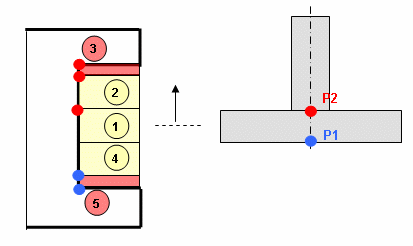
- Combined with Top/Bottom machining.
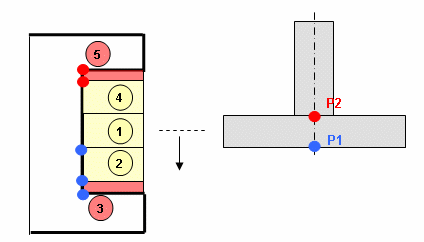
- Combined with Bottom/Top machining.
- Middle alternate
- Combined with Top/Bottom machining.
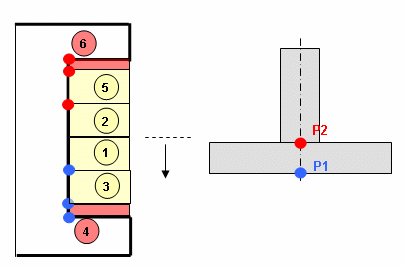
- Combined with Top/Bottom machining.
![]()
Axial Parameters
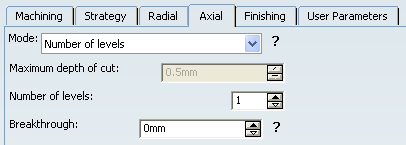
- Mode
- The options in the
Mode dropdown combo box define how the distance
between two consecutive levels is computed, and are as follows:
- Maximum depth of cut
- Number of levels
- Number of levels without top.
- Maximum depth of cut
- Defines the maximum depth of cut in an axial strategy.
- Number of levels
- Defines the number of levels to be machined in an axial strategy.
- Breakthrough
- Specifies the distance in the tool axis direction that the tool must go completely through the part. Breakthrough is applied on the bottom element, which must be specified as soft.
![]()
Finishing Parameters
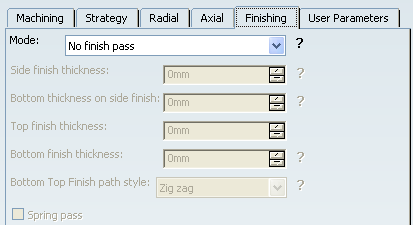
- Mode
- The options in the
Mode dropdown combo box indicate whether
or not finish passes are to be generated on the sides, top and bottom of
the area to machine, and are as follows:
- No finish pass
- Side finish at each level
- Top and/or Bottom finish
- Side finish and Top and/or Bottom Finish
Example of side, top and bottom finish combined with Top/Bottom machining.
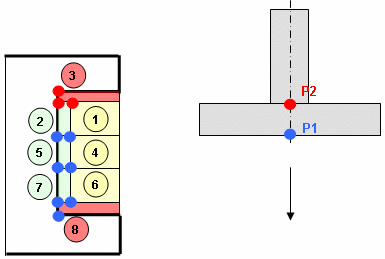
- Side finish thickness
- Specifies the thickness of material that can be machined when finishing
the flank of the groove.
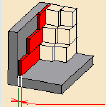
- Bottom thickness on side finish
- Specifies the bottom thickness used for
last side finish pass, if side finishing is
requested on the operation.
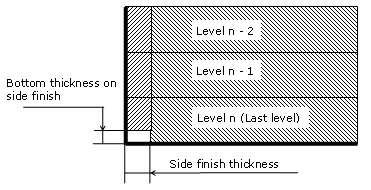
- Top finish thickness
- Specifies the thickness of material that can be machined when finishing the top of the groove.
- Bottom finish thickness
- Specifies the thickness of material that can be machined when finishing
the bottom of the groove.
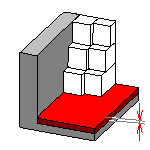
- Bottom Top Finish path style
- The options in the
Bottom Top Finish path style dropdown combo box define
the finish path style for the top and bottom finish passes, and are as follows:
- Zig zag
- or One way
![]()
Geometry
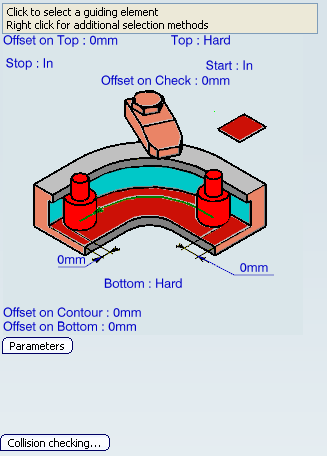
Tool follows a guiding contour between top and bottom of the groove while
respecting geometry limitations and machining strategy parameters defined by you.
You can specify the following geometry:
- Bottom (planar face or surface) with possible Offset on Bottom. Bottom may be Hard or Soft.
- Top plane with possible Offset on Top. Top may be Hard or Soft.
- Open or closed Guiding contour (edges or sketch) with possible Offset on Contour.
- Start and Stop relimiting elements with possible Offsets. They can be points or curves.
- Check elements with possible Offset on Check.
- Collision checking
- Collision checking is done during macro motion. Collision checking lets you deactivate collision checking
with the guides in the dialog box that appears.

 By default,
Include Guiding elements is selected and all guiding elements
defined on the operation are taken into account during this verification.
By default,
Include Guiding elements is selected and all guiding elements
defined on the operation are taken into account during this verification.
![]()
Feedrates and Speeds Parameters
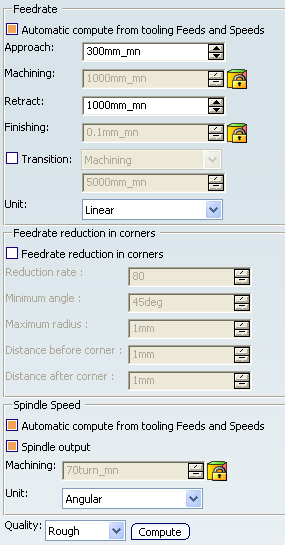
- Feedrate: Automatic compute from tooling Feeds and Speeds
- This check box allow an operation's feeds and speeds values to be updated automatically when the tool's feeds and speeds values are modified.
You can specify the following feedrates:
- Approach
- Machining
- Retract
- Finishing
Note:
The above feedrates can be defined in linear (feed per minute) or angular (feed per revolution) units.
- Angular: feedrate in revolutions per minute and unit is set to mm_turn.
- Linear: feedrate in feed per minute and unit is set to mm_mn.
- Transition
- You can locally set the feedrate for a transition path to a
machining operation B from a machining operation A or from a tool
change activity. This is done by selecting the Transition check box in the Machining Operation dialog box for
operation B.
For more information, please refer to the Setting a Transition Feedrate.
- Feedrate Reduction in Corners
- You can reduce feedrates in corners encountered along
the tool path depending on values given in the Feeds and Speeds
tab page:
- Reduction rate
- Maximum radius
- Minimum angle
- Distance before corner
- Distance after corner
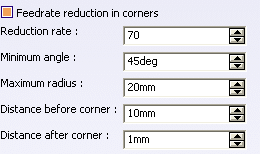
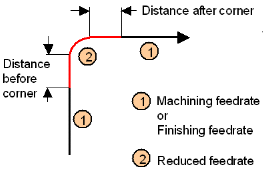
Feed reduction is applied to corners along the tool path whose radius is less than the Maximum radius value and whose arc angle is greater than the Minimum angle value. Corners can be angled or rounded.
For Groove Milling, feedrate reduction applies to inside corners for machining or finishing passes. It does not apply for macros or default linking and return motions.
If a cornering is defined with a radius of 5mm and the Feedrate reduction in corners set to a lower radius value, the feedrate cannot be reduced.
- Spindle Speed: Automatic compute from tooling Feeds and Speeds
This check box allow an operation's feeds and speeds values to be updated automatically when the tool's feeds and speeds values are modified.
If the Feedrate Automatic compute check box is selected and the Spindle Speed: Automatic compute from tooling Feeds and Speeds check box is not selected, then only the feedrate values can be computed. If both are not selected then automatic updating is not done.
When you modify a tool's feeds and speeds, all existing operations with the Automatic compute check boxes selected that use this tool (or an assembly using this tool) can be recomputed.
- Spindle output
- This check box manage output
of the SPINDL instruction in the generated NC data file:
- If the check box is selected, the instruction is generated.
- Otherwise, it is not generated.
Note:
Spindle speed is applied on the different motions of the operations (including approach, retract, linking macros). Spindle can be re-defined with Spindle tool motion. The spindle speed can be defined in linear (length per minute) or angular (length per revolution) units.
- Angular: length in revolutions per minute and unit is set to mm_turn.
- Linear: length in feed per minute and unit is set to mm_mn.
- Quality
- The feed and speed values are computed according to the Quality setting on the operation.
- Compute
- Feeds and speeds of the operation can be updated according to tooling feeds and speeds by clicking the Compute button located in the Feeds and Speeds tab of the operation.
Feeds and speeds of the operation can be updated automatically according to tooling data and the Rough or Finish quality of the operation. This is described in About Feeds and Speeds.
![]()
NC Macros
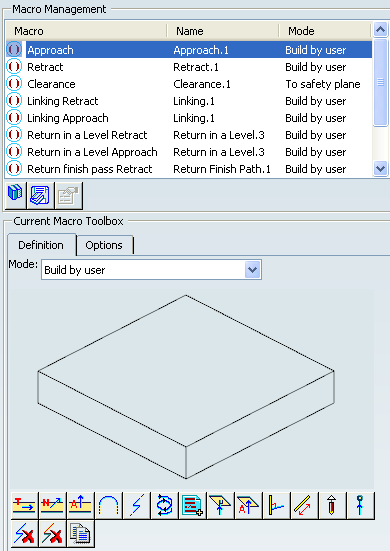
You can define transition paths in your machining operations by means
of NC macros:
- Approach: to approach the operation start point,
- Retract: to retract from the operation end point,
- Linking:
- to link two non consecutive paths
- to access finish and spring passes.
- Return in a Level to link two consecutive paths in a given level in a multi-path operation
- Return between Levels to go to the next level in a multi-level machining operation,
- Return to Finish Pass to go to the finish pass
- Clearance to avoid a fixture, for example.
The proposed macro mode for Approach and Retract macro are:
- None
- Build by user
- Circular horizontal axial
- Horizontal horizontal axial
- Axial
The proposed macro mode for Clearance macro are:
- Distance
- To a Plane
- To safety plane
For more information, please refer to the Defining Macros.
